1.4 Skills in the laboratory
|
Previous
1.3 Units
|
Next
1.5 Hazard signs
|
1.4 Skills in the laboratory (ESAP)
To carry out experiments in the laboratory you need to know how to properly present your experimental results, you also need to know how to read instruments and how to interpret your data. A laboratory (be it for physics, chemistry or other sciences) can be a very dangerous and daunting place. However, if you follow a few simple guidelines you can safely carry out experiments in the laboratory without endangering yourself or others around you.
Experiments (ESAQ)
When a scientist performs experiments the following process is followed:
-
Observe an event and identify an answerable question about the event.
-
Make a hypothesis (theory) about the event that gives a sensible result.
-
Design an experiment to test the theory. This includes identifying the fixed factors (what will not vary in the experiment), identifying the independent variable (this is set) and the dependent variable (what you will actually measure).
-
Collect data accurately and interpret the data.
-
Draw conclusions from the results of the experiment.
-
Decide whether the hypothesis is correct or not.
-
Verify your results by repeating the experiment or getting someone else to repeat the experiment.
This process is known as the scientific method. In the work that you will do you will be given the first three items and be required to determine the last four items. For verifying results you should see what your classmates obtained for their experiment.
In science the recording of practical work follows a specific layout. You should always present your work using this layout, as it will help any other person be able to understand and repeat your experiment.
-
Aim: A brief sentence describing the purpose of the experiment.
-
Apparatus: A sketch of the apparatus and a list of the apparatus
-
Method: A list of the steps followed to carry out the experiment
-
Results: Tables, graphs and observations about the experiment
-
Discussion: What your results mean
-
Conclusion: A brief sentence concluding whether or not the aim was met
To perform experiments correctly and accurately you also need to know how to work with various pieces of equipment. The next section details some of the apparatus that you need to know, as well as how to correctly work with it.
As you work through the experiments in the book you will be given guidance on how to present your data. By the end of the year you should be able to select the appropriate method to show your data, whether it is a table, a graph or an equation.
You will also need to know how to interpret your data. For example given a table of values, what can you say about those values. Also you should be able to say whether you are performing a qualitative (descriptive) or a quantitative (numbers) analysis.
Laboratory apparatus (ESAR)
Listed here are some of the common pieces of apparatus that you will be working with in the laboratory. You should be able to name all the apparatus listed here as well as make a simple sketch of it.
|
Item |
Photo |
Sketch |
|
Beaker |
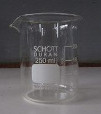 |
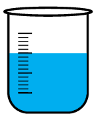
|
|
Flask |

|
|
|
Test tubes |
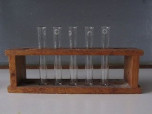 |

|
|
Bunsen burner |
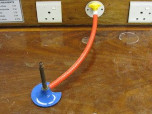 |

|
|
Measuring cylinder |

|
|
|
Pipette |
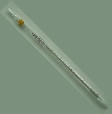 |

|
|
Watch glass |
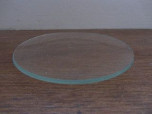 |

|
|
Thermometer |
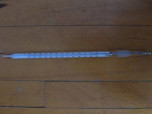 |

|
|
Funnel |
 |
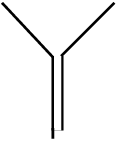
|
The following image shows the correct setup for heating liquids on a Bunsen burner:
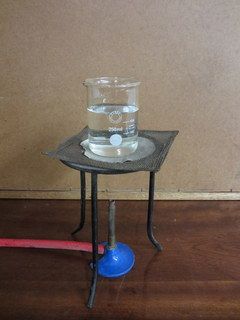
When reading any instrument (such as a measuring cylinder, a pipette, etc.) always make sure that the instrument is level and that your eye is at the level of the top of the liquid.
General safety rules (ESAS)
The following are some of the general guidelines and rules that you should always observe when working in a laboratory.
-
You are responsible for your own safety as well as the safety of others in the laboratory.
-
Do not eat or drink in the laboratory. Do not use laboratory glassware to eat or drink from.
-
Always behave responsibly in the laboratory. Do not run around or play practical jokes.
-
In case of accidents or chemical spills call your teacher at once.
-
Always check with your teacher how to dispose of waste. Chemicals should not be disposed of down the sink.
-
Only perform the experiments that your teacher instructs you to. Never mix chemicals for fun.
-
Never perform experiments alone.
-
Always check the safety data of any chemicals you are going to use.
-
Follow the given instructions exactly. Do not mix up steps or try things in a different order.
-
Be alert and careful when handling chemicals, hot glassware, etc.
-
Ensure all Bunsen burners are turned off at the end of the practical and all chemical containers are sealed.
-
Never add water to acid. Always add the acid to water.
-
Never heat thick glassware as it will break. (i.e. do not heat measuring cylinders).
-
When you are smelling chemicals, place the container on a laboratory bench and use your hand to gently waft (fan) the vapours towards you.
-
Do not take chemicals from the laboratory.
-
Always work in a well ventilated room. Whenever you perform experiments, you should open the windows.
-
Do not leave Bunsen burners and flames unattended.
-
Never smell, taste or touch chemicals unless instructed to do so.
-
Never point test tubes at people or yourself. When heating chemicals, always point the mouth of the test tube away from you and your classmates.
|
Previous
1.3 Units
|
Table of Contents |
Next
1.5 Hazard signs
|
